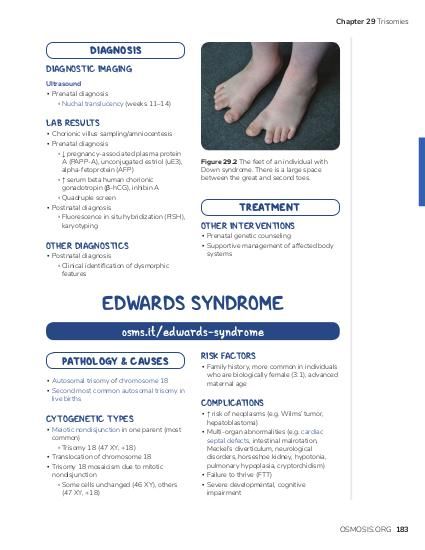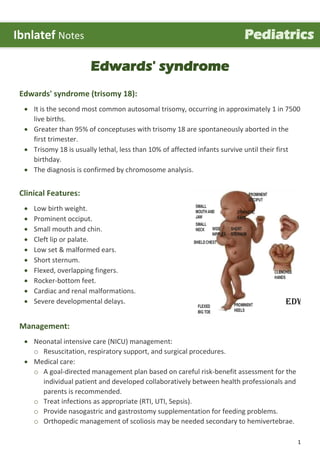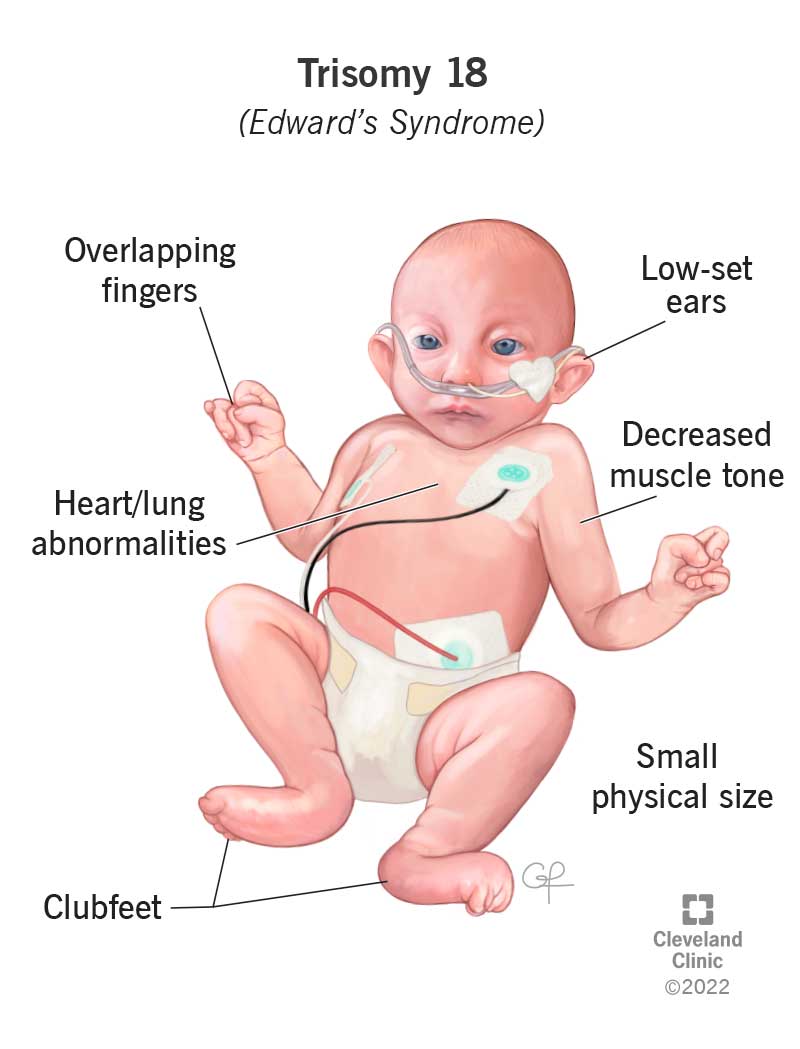If you’ve ever wondered about Edwards’ Syndrome and the potential risks and complications it presents, look no further. This article provides a detailed and comprehensive overview of this condition, delving into its various aspects and shedding light on the potential challenges and medical considerations involved. From understanding the genetic factors that contribute to Edwards’ Syndrome to exploring the possible complications that can arise, this article aims to equip you with the knowledge you need to better understand this condition. So, let’s dive in and discover more about Edwards’ Syndrome and the impact it can have.
Overview of Edwards’ Syndrome
What is Edwards’ Syndrome?
Edwards’ Syndrome, also known as Trisomy 18, is a rare genetic disorder that occurs when an individual has an extra copy of chromosome 18. This additional genetic material disrupts the normal development of the body and results in a range of physical, cognitive, and developmental challenges. Edwards’ Syndrome is a complex condition that impacts multiple systems in the body and often leads to severe medical complications.
Causes of Edwards’ Syndrome
Edwards’ Syndrome is caused by the presence of an extra copy of chromosome 18, which can occur due to errors in cell division during the formation of eggs and sperm. The majority of cases of Edwards’ Syndrome are not inherited and are instead the result of a random error that happens during the formation of the baby’s reproductive cells. Advanced maternal age is a known risk factor for the syndrome, as older eggs have a higher chance of having an extra copy of chromosome 18.
Prevalence of Edwards’ Syndrome
Edwards’ Syndrome is a relatively rare disorder, with an estimated prevalence of 1 in every 5,000 live births. It affects both males and females equally and occurs across all ethnic groups. However, the majority of affected babies do not survive until birth, and it is estimated that only 5-10% of babies with Edwards’ Syndrome survive beyond their first year of life.
Symptoms of Edwards’ Syndrome
The symptoms of Edwards’ Syndrome can vary widely among affected individuals, but there are several common physical and developmental characteristics associated with the disorder. These may include low birth weight, small head size, clenched fists with overlapping fingers, malformed ears, a small jaw, and a prominent back of the head. Individuals with Edwards’ Syndrome may also have heart defects, kidney problems, and a variety of other physical abnormalities.
Diagnosis of Edwards’ Syndrome
Diagnosing Edwards’ Syndrome can be challenging, as the condition is often not detected until late in pregnancy or after birth. Prenatal screening tests, such as ultrasound and blood tests, can provide an indication of the possibility of Edwards’ Syndrome, but a definitive diagnosis is typically made through genetic testing. This involves analyzing the baby’s chromosomes cells from blood samples or amniotic fluid. In some cases, Edwards’ Syndrome may be suspected during a physical examination of the newborn if characteristic physical features are present.
Risks and Complications Associated with Edwards’ Syndrome
Physical Complications
Individuals with Edwards’ Syndrome often face a multitude of physical complications that can affect their overall health and well-being. Common physical issues include congenital heart defects, respiratory problems, feeding difficulties, gastrointestinal abnormalities, and poor muscle tone. These complications require ongoing medical intervention and can significantly impact the quality of life for individuals with Edwards’ Syndrome.
Cognitive and Developmental Impairments
In addition to physical challenges, Edwards’ Syndrome is also associated with cognitive and developmental impairments. Most affected individuals experience intellectual disability and have developmental delays. They may have difficulties with speech and language development, learning, and mobility. It is important to provide early intervention and specialized therapies to support the cognitive and developmental needs of those with Edwards’ Syndrome.
Organ Malformations
Organ malformations are a common feature of Edwards’ Syndrome. These malformations can affect various organs in the body, including the heart, lungs, kidneys, and intestines. The severity of organ malformations can vary from mild to life-threatening, requiring surgical interventions and ongoing medical management. Timely diagnosis and regular monitoring are crucial to address these potential risks.
Feeding Difficulties
Feeding difficulties are a significant concern for individuals with Edwards’ Syndrome, often due to poor muscle tone and difficulty swallowing. Babies may have a weak suck, making breastfeeding or bottle-feeding challenging. They may need specialized feeding techniques, such as nasogastric tube feeding or gastrostomy tube placement, to meet their nutritional needs. Nutritional support and monitoring are essential to promote growth and overall well-being.
Breathing Problems
Respiratory issues are common in individuals with Edwards’ Syndrome due to structural abnormalities in the chest and lungs. These problems can range from mild to severe, leading to recurrent infections, difficulty breathing, and the need for respiratory support. Regular monitoring of respiratory function and prompt intervention are necessary to manage breathing problems and optimize the individual’s respiratory health.

Treatment and Care for Individuals with Edwards’ Syndrome
Palliative Care
Given the complexity and severity of the medical challenges associated with Edwards’ Syndrome, the primary focus of treatment and care is often on providing palliative care. Palliative care aims to alleviate pain and discomfort, enhance quality of life, and ensure that all medical and supportive needs are met. This multidisciplinary approach involves a team of healthcare professionals, including doctors, nurses, therapists, and social workers, who work together to address the individual’s physical, emotional, and social needs.
Management of Complications
Individuals with Edwards’ Syndrome require ongoing medical management to address the various complications that may arise. This includes regular monitoring, medical interventions, and surgical procedures as necessary. For example, cardiac surgery may be required to correct congenital heart defects, while respiratory support, such as oxygen therapy or ventilation, may be needed to manage breathing problems. Each case must be approached individually, and treatment plans should be tailored to the specific needs of the individual.
Feeding and Nutritional Support
Feeding difficulties are a common challenge in individuals with Edwards’ Syndrome. Specialist feeding support is essential to ensure adequate nutrition and hydration. This may involve working with a dietitian to develop a tailored feeding plan, considering factors such as feeding techniques, positioning, and the use of specialized formulas. In some cases, tube feeding may be necessary to provide adequate nutrition. Regular monitoring of growth and nutrition is crucial to optimize well-being.
Multidisciplinary Approach
The care and management of individuals with Edwards’ Syndrome require a multidisciplinary approach, including input from various healthcare professionals. This may include pediatricians, geneticists, cardiologists, pulmonologists, neurologists, physiotherapists, speech therapists, occupational therapists, and psychologists. Each member of the team plays a vital role in assessing and addressing the individual’s needs, providing specialized interventions, and supporting the overall well-being of the person with Edwards’ Syndrome.
Prognosis and Life Expectancy
Survival Rates
The prognosis for individuals with Edwards’ Syndrome is generally poor, and the majority of babies with the condition do not survive until birth. It is estimated that around 50% of affected pregnancies result in miscarriage, and only a small percentage of babies with Edwards’ Syndrome live beyond their first year. Survival rates for those who do survive beyond infancy vary, but long-term prognosis remains guarded, with many individuals facing significant health challenges throughout their lives.
Factors Affecting Prognosis
Various factors can influence the prognosis of an individual with Edwards’ Syndrome. The presence and severity of organ malformations, the individual’s overall health at birth, and their ability to tolerate medical interventions and treatments all play a role. Early diagnosis, timely interventions, and access to comprehensive medical care can improve the prognosis and quality of life for individuals with Edwards’ Syndrome.
Quality of Life
The quality of life for individuals with Edwards’ Syndrome can vary widely, depending on the severity of their symptoms and the level of medical and supportive care they receive. With appropriate interventions and support, some individuals with Edwards’ Syndrome can reach developmental milestones, communicate, and experience a reasonable quality of life. However, the presence of severe physical and cognitive impairments often requires ongoing assistance and support from caregivers and healthcare professionals.

Emotional and Psychological Impact on Families
Emotional Stress and Coping
The diagnosis of Edwards’ Syndrome can be devastating for families, as it forces them to confront the challenges associated with the condition and the uncertain future it presents. Many parents experience a range of emotions, including grief, guilt, sadness, and anxiety. It is crucial for families to have access to emotional support and resources to help them cope with the emotional stress of caring for a child with Edwards’ Syndrome. Support groups, counseling services, and connections with other families going through similar experiences can be invaluable in providing emotional support and guidance.
Financial Implications
Caring for a child with Edwards’ Syndrome can present significant financial challenges for families. The need for regular medical care, specialist interventions, therapy, and equipment can place a strain on family finances. Families may also face additional costs associated with adapting their homes and lifestyles to meet the needs of the child. Access to financial assistance programs, government support, and community resources can help alleviate some of the financial burdens families may encounter.
Support Services
Access to comprehensive support services is vital for families navigating the complexities of caring for a child with Edwards’ Syndrome. This may include access to specialized medical teams, early intervention programs, therapy services, and respite care options. Connecting with support groups and organizations dedicated to Edwards’ Syndrome can also provide families with valuable information, resources, and a sense of community.
Genetic Counseling and Prenatal Testing
Genetic Counseling
Genetic counseling is a crucial component of the care and support provided to families who have a child with Edwards’ Syndrome or who may be at risk of having a child with the condition. Genetic counselors can help families understand the implications of the syndrome, assess risk factors, and provide information about available testing options and reproductive choices. They offer guidance and support throughout the decision-making process and empower families to make informed choices about their reproductive health.
Prenatal Testing Options
There are several prenatal testing options available to assess the risk of Edwards’ Syndrome in a pregnancy. These may include non-invasive screening tests, such as maternal serum screening and ultrasound, which can provide an indication of the likelihood of the syndrome but cannot provide a definitive diagnosis. For a definitive diagnosis, invasive procedures such as chorionic villus sampling or amniocentesis may be performed to obtain a sample of the baby’s genetic material for analysis.
Decision-Making Process
The decision to undergo prenatal testing and the subsequent choices related to the results can be challenging for families. It is a deeply personal decision that requires careful consideration of individual beliefs, values, and preferences. Genetic counseling plays a vital role in supporting families through the decision-making process, providing them with information about the syndrome, the testing process, and the potential outcomes. Ultimately, families must make the decision that feels right for them and their unique circumstances.

Ethical Considerations
Termination of Pregnancy
The diagnosis of Edwards’ Syndrome may lead some families to consider termination of pregnancy. This is a deeply personal and complex decision that raises many ethical considerations. Each individual and family must make this decision autonomously, in consultation with healthcare professionals and taking into account their own beliefs, values, and circumstances. Ensuring access to non-judgmental, unbiased counseling and support throughout the decision-making process is essential.
End-of-Life Decisions
When caring for individuals with Edwards’ Syndrome, families may face difficult end-of-life decisions due to the complex medical challenges associated with the condition. These decisions can include the use of life-sustaining interventions, such as resuscitation, mechanical ventilation, and artificial nutrition and hydration. Families should have access to compassionate, open discussions about end-of-life care options, ensuring that their values and wishes are respected throughout the decision-making process.
Euthanasia Debate
The topic of euthanasia is a contentious ethical issue that is often debated in the context of severe medical conditions, including Edwards’ Syndrome. Euthanasia, or the intentional ending of a person’s life with their consent, is a complex and highly regulated area of medical practice and legal frameworks that varies widely across different jurisdictions. The ethical considerations surrounding euthanasia are deeply personal and may be influenced by cultural, religious, and societal values. Advocating for open, informed discussions about end-of-life care and promoting access to palliative care services is essential.
Advancements in Research
Current Research Studies
Advancements in medical research continue to expand our understanding of Edwards’ Syndrome and offer potential insights for improved management and treatment strategies. Research studies are exploring various aspects of the condition, including the underlying genetic mechanisms, potential therapeutic targets, and strategies to improve outcomes for individuals with Edwards’ Syndrome.
Genetic Insights
With advancements in genetic technologies, researchers are uncovering more about the genetic factors contributing to Edwards’ Syndrome. Improved understanding of the molecular mechanisms involved in the disorder may lead to potential therapeutic approaches and interventions that target specific genetic abnormalities associated with Edwards’ Syndrome.
Potential Therapeutic Approaches
While there is currently no cure for Edwards’ Syndrome, ongoing research aims to identify potential therapeutic approaches that may improve outcomes for affected individuals. These approaches may involve targeted interventions to address specific symptoms or complications associated with the syndrome. Advances in medical technology, such as surgery techniques and medical devices, may also play a role in improving outcomes and quality of life for those with Edwards’ Syndrome.

Awareness and Advocacy
National and International Organizations
Various national and international organizations are dedicated to raising awareness of Edwards’ Syndrome and advocating for improved support and care for affected individuals and their families. These organizations provide resources, support networks, and information to help families navigate the complexities of living with the condition. They also work to educate the public, healthcare professionals, and policymakers about Edwards’ Syndrome to promote understanding and support.
Edwards’ Syndrome Awareness Campaigns
Awareness campaigns focused on Edwards’ Syndrome aim to raise public understanding and promote empathy for individuals and families affected by the condition. These campaigns often involve sharing personal stories, highlighting the challenges faced by those with Edwards’ Syndrome, and advocating for improved healthcare resources and support services.
Raising Public Understanding and Support
Raising public understanding and support for Edwards’ Syndrome is crucial to ensuring that affected individuals and their families receive the necessary resources and care. Educating the public about the condition, sharing accurate information, and challenging misconceptions can help reduce stigma and promote inclusivity. Increased awareness can also lead to increased funding for research and improved access to healthcare services for individuals with Edwards’ Syndrome.
Conclusion
Edwards’ Syndrome, or Trisomy 18, is a complex genetic disorder that presents numerous challenges for affected individuals and their families. It impacts multiple aspects of health and development and requires comprehensive medical care and support. Although the prognosis for individuals with Edwards’ Syndrome is generally poor, advancements in research and increasing awareness offer hope for improved outcomes and quality of life. By providing compassionate care, tailored interventions, and support services, individuals with Edwards’ Syndrome can lead fulfilling lives, surrounded by a supportive and understanding community.
